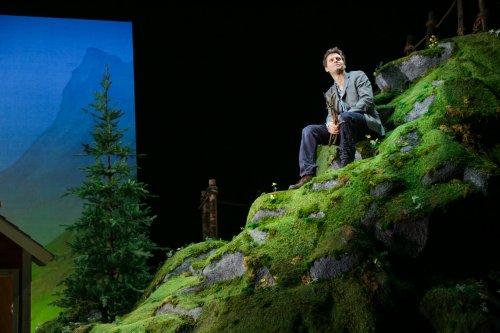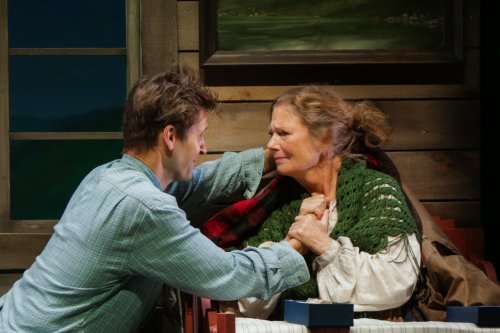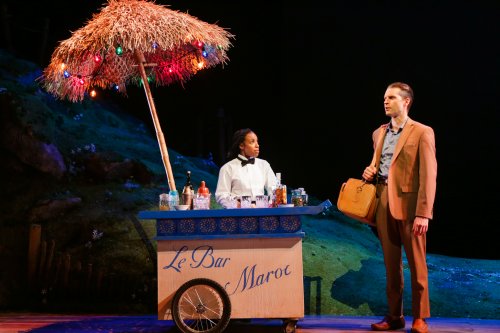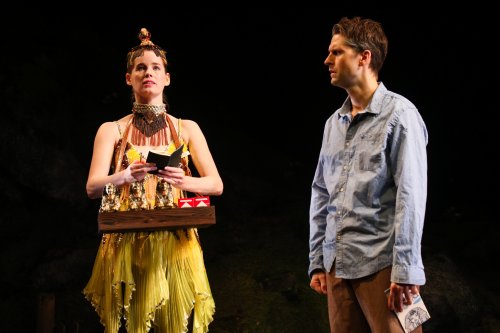Gnit
Will Eno’s wry, contemporary Gnit solves the problem of attempting to stage Ibsen’s unwieldy, five-hour verse play "Peer Gynt."

Joe Curnutte in a scene from Will Eno’s “Gnit” at Theatre for a New Audience (Photo credit: Gerry Goodstein)
[avatar user=”Victor Gluck” size=”96″ align=”left”] Victor Gluck, Editor-in-Chief[/avatar]
American playwrights have long been been drawn to the works of Henrik Ibsen, take for example, Thornton Wilder’s version of A Doll’s House, Arthur Miller’s An Enemy of the People, Thomas Babe’s The Wild Duck, and Arthur Kopit’s Ghosts. Some playwrights have been commissioned to make new English language translations from the original Norwegian, others to update the plays to the present, and still others have been drawn to Ibsen’s plays as they coincided with their social or political beliefs.
Will Eno’s wry, contemporary Gnit solves the problem of attempting to stage Ibsen’s unwieldy, five-hour verse play Peer Gynt. The play given its world premiere at the Humana Festival of New American Plays in 2013 is now making its New York debut at Theatre for a New Audience in a production directed by Oliver Butler, a longtime collaborator with Eno. Heavily influenced by the plays of Samuel Beckett and Eugene Ionesco, Gnit is a journey of the self to enlightenment with travel throughout the world. Part road movie, part folklore, and part horror story, Gnit makes an old play new again.

Joe Curnutte and Deborah Hedwall in a scene from Will Eno’s “Gnit” at Theatre for a New Audience (Photo credit: Gerry Goodstein)

Jasmine Batchelor and Joe Curnutte in a scene from Will Eno’s “Gnit” at Theatre for a New Audience (Photo credit: Gerry Goodstein)
Described as “a willfully American misreading of Henrik Ibsen’s Peer Gynt” when the play was presented at the Actors Theatre of Louisville in 2013, it is actually more faithful to the original than one would expect. However, it substitutes modern equivalents for fanciful or folkloric events in Ibsen’s verse drama: Peer’s tale of the reindeer hunt becomes a story of chasing a wild dog; the trolls become a family of murderous real estate agents but Gnit still meets them in the hills; the mythological character the Boyg is here renamed the Middle. Eno’s play begins in an unnamed country although the semi-realistic unit design by Kimie Nishikawa depicts two hills and a valley between with a distant view of mountains, much like Ibsen’s Scandinavia.
The hero renamed Peter Gnit leaves his dying mother to go “on a journey to discover, to uncover, the authentic self.” This picaresque tale begins in his own country as he attends the wedding of a former girlfriend, and runs off with the bride, abandons her as he has an encounter with the woman in green and has a child by her, and then meets Solvay, the love of his life. Restless, he travels the world, ending up in Morocco as a rich man, where he is robbed. Visiting Egypt, he talks to the Sphinx, and meets the keeper of a madhouse. Eventually, he makes his way back home, attends a funeral of a man he once knew, only to find that it is too late to pick up where he left off 30 years before. Has he learned anything before the end? Is life fair to anyone?

David Shih and Joe Curnutte in a scene from Will Eno’s “Gnit” at Theatre for a New Audience (Photo credit: Gerry Goodstein)

Christy Escobar and Joe Curnutte in a scene from Will Eno’s “Gnit” at Theatre for a New Audience (Photo credit: Gerry Goodstein)
The dark humor of Ibsen’s play is very much in keeping with Eno’s world view and many of the episodes are both droll and sardonic. Aside from Joe Curnutte’s deadpan everyman, a lovable rogue, as Peer Gnit, the play uses five versatile actors to play all of the other characters: Jasmine Batchelor, Jordan Bellow, Christy Escobar, David Shih, and a fine Deborah Hedwall as Peter’s ironic, wise and bitter mother. Among other characters, Shih plays a clever invention of Eno’s called Town in which he incorporates many people in one. All are attuned to the play’s wry humor as well as the flat, muted directorial approach in this modern tragicomedy.
In addition to the attractive scenery in shades of green plus additional set pieces, it has taken two costume designers (Ásta Bennie Hostetter and Avery Reed) to accommodate the 33 characters. The lighting by Amith Chandrashaker makes gradual often subtle changes for the many scenes in this epic play. Jon Knust is responsible for the multitude of props for scenes that take place all over the world. The New York premiere of Will Eno’s Gnit has been a long time in coming, but was definitely worth the wait.
Gnit (through November 21, 2021)
Theatre for a New Audience
The Samuel H. Scripps Mainstage of the Polonsky Shakespeare Center, 262 Ashland Place, between Flatbush and Lafayette Avenues, in Brooklyn,
For tickets, visit http://www.tfana.org
Running time: two hours and ten minutes with one 15 minute intermission






Leave a comment